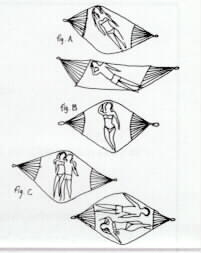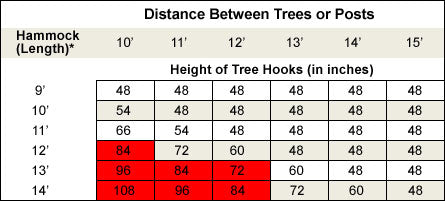Hammock FAQ
How to Choose your Hammock
What type of hammock is best?
Spreader bars or no?
Can I use my hammock as a bed? Which hammocks are best for sleeping in?
Hanging & Caring for your Hammock
Hanging & Care Instructions
How much space do I need to hang my hammock?
What height do I need to hang my hammock?
What is my hammock's weight capacity?
Will hooks damage my trees?
How to install hanging posts?
How do I hang my swing?
Hammocks* – Imperative Dos and absolute Don’ts
8 Imperative Rules for Hammock Safety
What type of hammock is best?
We carry a wide variety of hammocks and each has their own unique features. The best place to start is by viewing our “Quick Hammock Buying Guide below:

PLEASE NOTE: For durability and longevity, we recommend storing any hammock after use. Unnecessary exposure to the elements will reduce its life span.
View Rope Hammocks
View Quilted Hammocks
View Mayan Hammocks
View Brazilian Hammocks
View Nicaraguan Hammocks
View Poolside Hammocks
View Camping Hammocks
View all Hammocks
View Hammocks with Stands
Rope Hammocks
Whether it’s from watching reruns of “Gilligan’s Island” or “Robinson Crusoe,” a rope hammock is the first image that comes to the mind of most people. Rope hammocks are recognized as the most tradition form of hammocks. Generally made of cotton or polyester, rope hammocks come with spreader bars that separate the two sides, thus keeping it open for easy access and offering support. Rope hammocks can be hung between two trees or posts, as well as used in conjunction with a prefabricated stand.
Hammocks made of cotton ropes are considered by most to be more comfortable, as the ropes will stretch and match the contour of the body. The drawback is moisture; the cotton absorbs it and makes it more prone to mildew.
Hammocks made of polyester ropes are more durable. They are better able to withstand the effects of the elements, such as high humidity levels, salt air and ultraviolet rays. The polyester ropes are less susceptible to mold and mildew, meaning they can be expected to last longer. The ropes are less flexible than cotton, but not necessarily any less comfortable.
It is important to measure your area before hanging your hammock. Because most rope hammocks are 13-feet long, your trees or posts should be at least 13 to 17 feet apart. If that’s not possible, you’ll need a hammock stand.
Because of the large space created by the woven ropes, the rope hammocks are not recommended for young children. It can be easy for small children to get their hands or feet caught by the hopes in the ropes.
Quilted Hammocks
A quilted hammock is similar in style to a rope hammock, as it also includes wooden spreader bars. But the quilted hammock features two layers of fabric with some sort of filling (usually a polyester material) between them to offer additional comfort. The quilted hammocks are also reversible, usually with a pattern on one side and a solid color on the other. This is like getting two hammocks for the price of one.
The quilted hammocks can be enjoyed anywhere and are ideal for a cooler climate. The quilted hammocks can also be stretched between two trees or used with a stand. With no gaps or holes in the surface, the quilted hammock is an excellent choice for families with young children.
Mayan Hammocks
The bright colors and unique appeal make the Mayan-style hammocks a popular choice for many people. Craftsmen who make the hammocks use a thin string that creates a very flexible, but very supportive product. Mayan hammocks may be constructed of cotton or nylon thread and come without a spreader bar.
The cotton Mayan-style hammocks are softer and conform more easily to a body’s size and shape. Made of natural cotton fiber, this variety can be used outdoors, but will last longer if sheltered from the weather in a setting such as a porch unless hammock protection such as a hammock sock is used.
The nylon Mayan-style hammocks are more durable and less susceptible to the mold and mildew problems that occur with the cotton variety. An added plus: the sheen of the nylon string helps add intensity to the already bright fabric.
Mayan-style hammocks may be lightweight, but they are capable of holding a large amount of weight. They don’t have a spreader bar, which makes them popular with outdoor enthusiasts, such as backpackers, campers or those who enjoy spending time in the back country.
The strength of the strings on these hammocks will is surprising, but they can also be easily damaged. Commonly items such as buttons and zippers can hurt the weave on these hammocks. Those who plan a heavy-duty use for their hammocks may consider the thick-stringed version, which has the same level of comfort but offers additional durability.
Brazilian Hammocks
Hand woven from cotton fibers and crafted into lovely thick fabrics, the Brazillian hammocks are known for their variety of colors and the elaborate fringe that offers a unique look. Brazillian hammocks are both comfortable and aesthetically pleasing. They can be used indoors or outdoors.
The Brazillian style hammock is a good choice for families with children, as the hammock bed is solid, with no holes in the weave. This also means there is no air flow, which is ideal for use in cooler climates or on cooler summer nights.
Most Brazilian hammocks do not have spreader bars, creating a cocoon effect. There is, however, a special model with spreader bars that creates the same bed-like effect that’s similar to that of a rope or quilted hammock.
Nicaraguan Hammocks
Spun using soft cotton cords by using a double-weave technique, the Nicaraguan-style hammocks offer comfort and beauty. Some varieties are available with a special fringe, which adds to the uniqueness of the product. The Nicaraguan hammocks typically come without spreader bars.
The weave is similar to that found in a Mayan hammock, but is pulled together much tighter. This means the Nicaraguan weave is more durable and harder to snag or tear with buttons and zippers. The unique weave also allows the ideal amount of air to flow, which makes it adaptable for almost any climate or temperature.
While these hammocks are usable either indoors or outdoors, it is suggested they not be left outdoors for extended lengths of time when not being used unless hammock protection such as a hammock sock is used.
Poolside Hammocks
Exceptional fabrics make the poolside hammocks the most durable option. They are ideal for those who want a place to spend time by the pool or take long to the beach.
The poolside hammocks are perfect for anyone in a warmer climate or who lives close to the ocean. They are created from fabric that is more resistant to fading, less susceptible to mold and mildew, and able to take the incessant wetting and drying that comes from wet swim suits.
Poolside hammocks come with spreader bars and are sold in a variety of colors and patterns. The fabric may not be as comfortable as other spread bar styles, but you more than make up for it by gaining durability. These units can be placed on stands on the deck of a pool or hung between a couple of trees near a babbling brook.
These poolside hammocks are easy to clean, too. A solution of warm water and liquid soap can take care of most problems. You can also use a diluted solution of bleach water to knock out any mildew that might pop up.
Camping Hammocks
Lightweight and portable, these camping hammocks are a superlative choice for those who enjoy the outdoors or who want a simple source of safe outdoor sleeping on an overnight trip.
Using a camping hammock means you won’t need to sleep on the damp ground while on your cycling or backpacking journey. And with these hammocks made of durable, lightweight material, you won’t be taking up valuable space, either.
The camping hammocks are typically hung between two trees. Some of them even come with built-in stand.
Spreader bars or no?
This is a question of personal taste. Spreader bars are usually found on rope hammocks, quilted fabric hammocks or poolside hammocks. They are usually made of wood and serve to keep the hammock open at both ends. They can enhance the look of a hammock (beautiful traditional style), however, they can also be more prone to tipping.
Can I use my hammock as a bed? Which hammocks are best for sleeping in?
Absolutely! Millions around the world use hammocks as beds every night. We recommend sticking to non-spreader bar hammocks as beds (in case of sleep movement). In particular, Nicaraguan, Mayan and Brazilian Hammocks make the most comfortable beds (sponge effect). The Nicaraguans, Mayans and Brazilians have used them as beds for generations. Check out our blog post "The 5 Night Hammock Bed Experiment" for more insight on this.
HAMMOCK HANGING & CARE INSTRUCTIONS
Mayan Hammocks
- Getting Into your Mayan hammock:
NEVER climb in feet first. Sit with your back to the hammock, as if you were sitting on a chair. Reach behind you and spread out the hammock before sitting (this will ensure you make full use of the space and your weight is distributed evenly). Now sit, lay back and relax.
- Finding an Angle:
The most comfortable way to enjoy your Mayan hammock is to lay at an angle. This ensures better distribution of weight, lessening tension, and greater back support. Feel free to experiment to find your favorite position.

- Hanging Indoors:
Hang hammock from wall studs or ceiling beams. Find center of stud or beam and screw in hooks with a power drill. Ropes or chains can be used to compensate for extra distance. Never hang loops end directly from hanging hook. Suggested distance is 12+ feet.
- Hanging Outdoors:
Can be hung from trees, strong fence posts, side of garage, patio beams, etc… Hammock should be hung about 6 feet from the ground. Use rope or chain to compensate for extra distance. Never hang loops end directly from hanging hook. Suggested distance is 12+ feet.
- Mayan hammock Care:
* Hand wash in mild detergent
* Always tie up arms to avoid tangles
* To store hammock, hang both ends from one hook on the wall, or fold and store (fig. 1)
* Never hang hammock directly on hooks as friction may occur. Instead, loop a chain or rope from a hook through the loop end of the hammock (fig. 2)
* Should a string break on a hammock, tie the 2 broken ends to avoid the development of a hole

Rope Hammocks
- rope hammock Care:
While our rope hammocks are made to be thoroughly enjoyed indoors and especially outdoors, like all things natural the spreaders are eventually susceptible to the elements. It's a good idea to wax them regularly, to help prevent moisture from affecting the wood and to extend the beauty of the spreaders. In addition, since sharp-toothed animals are everywhere, count them among the elements! Some have a predilection for hammock cord to line their nests, or simply to have something to chew on. So when hanging or storing your hammock, make sure it is out of reach of such animals.
- Hanging your rope hammock:
The hammock should be strung between two solid support structures preferably the length of the hammock apart or slightly more, but a little less is doable. Solid support structures include strong trees, sturdy well-secured posts, and a portable hammock stand. Our stands are 2 or 3 feet longer than the hammocks, and come with chains to bridge the gap.
Always ensure that the hammock is securely attached. This means, if you're using hooks to attach to a tree, turn the hooks deep into the wood, not just into the bark of the tree. Since every good hammock has a little "give" when you lie in it, install the hooks about 4 feet from the ground to avoid "scraping bottom". You can also adjust the tightness of the hammock: the tighter it's stretched, the higher you stay off the ground. Always ensure that the hammock is safely located. This means that you should not hang it too close to the edge of your deck or any other precipice, or anywhere someone might get hurt after getting out in an uncontrolled fashion.
Brazilian Hammocks
- Brazilian hammock Care:
Our Brazilian Hammocks can be left outdoors, but will fade like that comfortable pair of jeans with the sun. Your hammock should not be put away wet… avoid mildew! Hand wash with mild detergent and hang dry… no machine washing of drying, please!
- Hanging Brazilian Hammocks:
Hang with a deep " U " curve and lay diagonally in the Brazilian Style
How much space do I need to hang my hammock?
The optimum distance for hanging a hammock is 10-15 feet. If the distance is LESS than that, it will be necessary to raise the location of the hooks. If the trees are MORE than the recommended distance, you can compensate with one of our hammock hanging accessories. Our flexible hammock stands are also a good option. Hanging distance needed for specific hammocks will be visible on the product screen when selecting your hammock (also shown in the graph below).
What height do I need to hang my hammock?

* RED: Not Recommended
* Distance measured from loop end to loop end
What is my hammock's weight capacity?
That depends on the hammock. Weight capacities are listed for all our individual hammocks in their descriptions. At the minimum, our hammocks can support one very large adult (often many more).
Will hooks damage my trees?
Not likely, however, we recommend not taking the risk if you care about your trees. Instead of leaving holes in your trees, consider using hammock hanging accessories.
How to install hanging posts?
These supports can be metal or wooden poles. The poles must be buried in the ground to a depth of 1.5 to 2 feet. Additionally, the support poles should be cemented following the package instructions for the cement mixture.
How do I hang Hanging Hammock Chairs?
Hang from a solid beam. Ensure the structure should be solid and able to hold a large weight capacity.
Hammocks* – Imperative Dos and absolute Don’ts
8 Imperative Rules for Hammock Safety1- Always Remember that a Hammock is not a toy, a swing or anything other than a hammock. It’s a resting hanging device. If a Resting Hanging Device is not what you have in mind, you should look for a better suited product.
2- Hammock installation or setup can be simple or complicated depending on the terrain and the available structural devices. Check your surroundings, above and below, and make sure to choose suitable, mature and healthy trees or anchor points that can safely support the Hammock Universe hammock and its occupant(s). If you are not sure or doubt your ability to install your hammock properly and safely, then it is imperative and crucial you seek professional help to do so.
3- Never install a hammock high above ground. Your hammock installation should be resting inches above the ground. Never hang a hammock higher than 18” above the ground.
4- Always install a hammock over a soft and forgiving terrain. Never over sharp and hard surfaces.
5- Always inspect your hammock, your accessories, your hardware, and your structure before each use. Look for tears, weakness in all the above. If you see anything abnormal or doubt the installation, do not use the hammock, and seek assistance to immediately replace any damaged or worn components.
6- Never let your child unattended in your hammock. Direct and constant parental or adult supervision is mandatory.
7- Selecting the proper hammock is important. Some hammocks are easier to use than others. Age, weight, intended use (sleep, rest, lounge) all play an important factor in the decision making to purchase a hammock and safely use it.
8- Remember to always follow these rules to minimize the risk of a very serious accident. Remember there is always an inherent risk of injuries when using a hammock. Following these rules should minimize the risks but does not make it a risk-free device. Treeka Stores, Inc. (“Hammock Universe”) will not be liable for any damage or injury as a result of incorrect installation, improper use, or alteration.
*Hammock (the word hammock includes, hammock, hammock chair, hammock stand and accessories)
